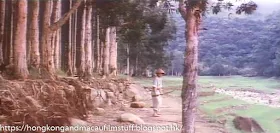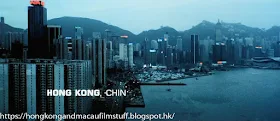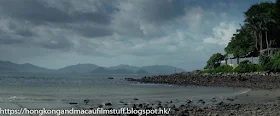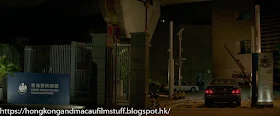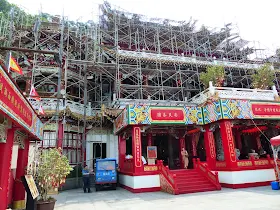I'm a big fan of King Hu films no matter on where they were made. Some were made solely in Hong Kong (e.g. The Valiant Ones, The Fate of Lee Khan) others in Taiwan (e.g. Dragon Inn) and some were split between the two (e.g Come Drink With Me, A Touch of Zen).
The Valiant Ones was made, pretty much, back-to-back with The Fate of Lee Khan in 1972. Although The Fate of Lee Khan was released the next year in 1973, for some reason The Valiant Ones had to wait until 1975 to see the light of day.
Chaplin Chang was working for King Hu at the time, in the production company offices in Yau Yat Chuen in Kowloon. I met him a few years ago and he told me that these two films had been agreed to be funded by Raymond Chow. Raymond had said he would fund both films and in return Golden Harvest would take full control of The Fate of Lee Khan once complete whereas The Valiant Ones would remain the property of King Hu Productions. Raymond was a renowned skinflint and delayed the funding for months on some pretext or another and it wasn't until he needed to borrow Chaplin for his own production of Bruce Lee's The Way of the Dragon, that Chaplin was able to get Raymond to sign the contracts and issue the first stage of the funding.
It's most likely that because The Valiant Ones remained the property of King Hu that there was a much bigger delay in getting it into the cinemas as opposed to The Fate of Lee Khan that slipped easily into the well-oiled machinery of the Golden Harvest engine.
Anyway, seeing as this is a locations blog, we may as well start off with the major location used in The Valiant Ones: Shing Mun Reservoir. In fact, Shing Mun Reservoir has been a popular location for countryside filming in Hong Kong for many years - particularly throughout the 70s and 80s. A good place to see examples is Andi's Movie Tours blog. Other than the water level in the reservoir, really not much changes here and to top it all off it is quite easy to get to if you are on a nostalgia trip. Shing Mun is definitely in the top five of outdoor filming locations in Hong Kong.
In this film it is the camp of the so-called "Valiant Ones" as well as acting as the location for the two major battle scenes. Most of the filming was done at the north end of the reservoir where there is a large collection of the silver barked trees that you can see below. The reservoir still has a large number of these and it wouldn't surprise me if they were the exact same trees in many cases. You can see on Andi's blog that the rocks haven't really changed much, the only thing is that looks different is the covering of grass that is obvious in the screenshots below.
General
▼
Bruce Lee self-guided Tours (work in progress)
▼
Friday, November 30, 2018
Saturday, November 24, 2018
Ein Sarg aus Hong Kong - Heinz Drache (1964) - Muk Min Ha, Tsuen Wan
Another one from the vaults. This is a screen grab from Ein Sarg aus Hong Kong and was filmed in Tsuen Wan - specifically in front of a village called Muk Min Ha next to the Tai Ho Road (the road the car is on). I think this old village stayed around until the 1980s when it was eventually turned into the small section of streets in front of Tsuen Wan MTR station. In fact, the white building at the back (sorry, not sure of its name, please comment if you know) pretty much occupies the space that became the station. The villagers were resettled a bit further up the hill at the back - by Route Twisk.
Wednesday, November 21, 2018
Contagion - Matt Damon (2011) - Hok Tau, Fanling
Better late than never, but this is sometimes the way it goes with the more obscure locations. I've finally found the rural area where the Chinese village scenes were filmed for Contagion. If you can recall, this is the village where Marion Cotillard's character is kidnapped and taken to whilst a vaccination is formulated to counter the pandemic. It turns out the place is fairly off-the-beaten-track after all. The general area is close to Hok Tau village and reservoir but the specific area used for filming is just north of a small village called San Uk Tsai (新屋仔) about 1km north of the Rainbow Strawberry Farm (assuming that place is still open).
Spy Game - Robert Redford (2001) - Central, Hong Kong
The final sequence is the one that sells us the lie that the HSBC building in Central is actually the US Consulate. In fact, not a single on-site shot was done here and all of David Hemmings' scenes were filmed back in London - at Lloyd's of London on Lime Street. The various shots of Hemmings in the external glass lift quite clearly reveal Leadenhall Street in the background and not downtown Hong Kong as we are supposed to think. On the plus side we do get brief glimpses at the former Prince of Wales building in HMS Tamar, the Furama Hotel and Ritz Carlton. Both these latter two have since given way to redevelopment.
Tuesday, November 20, 2018
Spy Game - Robert Redford (2001) - Victoria Harbour Part 2, Hong Kong
The second sequence is one that swoops across the harbour from the opposite direction and is the sequence over which the film title is overlaid. We see the Convention Centre in the first image and the camera quickly zips by to focus at the same point that was reached in the initial sequence - in front of Elizabeth House with its Panasonic advert.
Monday, November 19, 2018
Spy Game - Robert Redford (2001) - Victoria Harbour Part 1, Hong Kong
It's a slow time for my chosen selection of films at the moment, so maybe it's time to dig out some classics. Case in point is Tony Scott's Spy Game released in 2001. This really isn't a made in Hong Kong film at all, there are really only three very brief snippets of Hong Kong - all of them essentially establishing sequences that set the scene for what follows. What follows is usually David Hemming's character, supposedly base in Hong Kong and speaking from what is purported to be the US Consulate.
The first establishing sequence we see involves the camera zooming along the harbour from the east towards a building in Wanchai, Elizabeth House in Causeway Bay.
Friday, November 16, 2018
Man of Tai Chi - Keanu Reeves (2013) - Shatin Treatment Works, Shatin
The initial raid of the fight venue takes place in some sort of unnamed industrial complex. But a closer examination of the background reveals it to have been filmed at Shatin Treatment Works at the far end of the Shing Mun River nullah.
Wednesday, November 14, 2018
Man of Tai Chi - Keanu Reeves (2013) - Ngam Tau Sha, Sai Kung
Reeves' mansion in the film, a place where Karen Mok spends an inordinate amount of time spying on him, was supposedly on some nondescript part of the Hong Kong coast. The actual scenes of the estate look to have been filmed elsewhere but the external shots were all done over in Sai Kung by Little Palm Beach, on a small promontory called Ngam Tau Sha. I believe older readers who were in Hong Kong before the handover may recall it was also informally called "Target Island" for a while because the airforce and navy would use it for target practice. Large wooden bulls-eye targets were erected on the flat part of the land and then subsequently bombed and strafed with gun fire. In reality, it now houses a couple of private residences and a sailing club.
Tuesday, November 13, 2018
Man of Tai Chi - Keanu Reeves (2013) - Electrical & Mechanical Services Department, Kowloon Bay
The exterior of the Police HQ was also filmed in Kowloon Bay, at the new Electrical and Mechanical Servies Dept building on Kai Shing Street. Obviously the signboards are fake. The large column centre screen is actually one of the uprights for the Kwun Tong Bypass. Apparently,this building wasn't new and was originally the air freight terminal for neighbouring Kai Tak Airport. It must've undergone a significant refurb to make it ready for the EMSD once they moved from their previous, shared location on Caroline Hill (edit 2023: which incidentally, is now demolished).
Monday, November 12, 2018
Man of Tai Chi - Keanu Reeves (2013) - Wang Tai Road, Kowloon Bay
The establishing shot for Reeves' office building was done over in Kowloon Bay at a relatively new building called Exchange Tower. Although the subsequent view from Reeves' office (last image) is looking towards Central on Hong Kong Island from the Grand Hyatt Hotel in Wanchai.
Office set in the studio with a backdrop filmed from the Grand Hyatt
Sunday, November 11, 2018
Man of Tai Chi - Keanu Reeves (2013) - Stonecutters Bridge, Kowloon
No longer Hong Kong's newest bridge, Stonecutters Bridge has been featured in a few films since it was opened at the tail end of 2009. In this scene it is the route that Tiger's car takes when he is brought to Hong Kong to meet Reeves for the first time.
Saturday, November 10, 2018
Man of Tai Chi - Keanu Reeves (2013) - Lung King Street, Wanchai
Man of Tai Chi is Keanu Reeves' directorial debut and centres around a rather evil minded businessman (Reeves) who manipulates skilled martial artists into fighting to the death for his (unbeknownst to them) pay-per-view internet channel. The police (i.e. Karen Mok) have been trying to bust the operation and the film starts with the killing of their main witness after he fails to kill his opponent in a fight.
The filming of this was split between Mainland China and Hong Kong and to be honest there aren't that many worthy locations in Hong Kong because it appears that much of the filming was done at Shing Fung Studios in Ho Chung.
After the initial killing, a police raid ensues and the fight venue is an industrial building somewhere. The exterior shots though were filmed in the area next to Lung King Street near to the Academy for Performing Arts. As the camera pans up we can see the surrounding buildings including Central Plaza and there is a subsequent shot taken on Lung King Street itself (see last image). This whole area has been subject to extensive redevelopment in the past ten years due to the Central/Wanchai bypass reclamation and it looks as though the canopy we see in the initial images was part of the (now demolished) Wanchai Sewage Screening Plant in the square bit of land that Lung King Street circles. It's entirely feasible that the interiors were actually shot there prior to demolition but I have no way to corroborate. You can still see the canopy on Streetview, but I'm not sure how long before it gets updated.
The filming of this was split between Mainland China and Hong Kong and to be honest there aren't that many worthy locations in Hong Kong because it appears that much of the filming was done at Shing Fung Studios in Ho Chung.
After the initial killing, a police raid ensues and the fight venue is an industrial building somewhere. The exterior shots though were filmed in the area next to Lung King Street near to the Academy for Performing Arts. As the camera pans up we can see the surrounding buildings including Central Plaza and there is a subsequent shot taken on Lung King Street itself (see last image). This whole area has been subject to extensive redevelopment in the past ten years due to the Central/Wanchai bypass reclamation and it looks as though the canopy we see in the initial images was part of the (now demolished) Wanchai Sewage Screening Plant in the square bit of land that Lung King Street circles. It's entirely feasible that the interiors were actually shot there prior to demolition but I have no way to corroborate. You can still see the canopy on Streetview, but I'm not sure how long before it gets updated.
Friday, November 9, 2018
The Chairman - Gregory Peck (1969) - Keelung, Taiwan
Better late than never, the last entry on the blog that comes as a result of my early summer trip to Taipei. This one will be familiar with anyone who read my The Sand Pebbles posts because this one also features Keelung.
I have yet to read a Gregory Peck or J. Lee Thompson bio (actor and director, respectively) so I can only suppose that Taiwan became the proxy for Mainland China once it became obvious that filming couldn't continue in Hong Kong. Their presence made the local Communist faction start their usual mouth frothing and as a result the Colonial Government requested they leave.
So we have a scene where Peck goes on a walkabout through a seemingly drab but lively environment and the existence of a recognisable piece of local architecture means we can easily identify the area in question as being in Keelung - the port city to the north east of Taipei.
In the top centre left of the first image above there is a familiar looking building. You may recall it was also seen in the Keelung-shot parts of The Sand Pebbles. It's the Lin Kai County Building (林開郡洋樓) that can be see behind Steve McQueen's head in this image.
The central waterway has since been covered and now has the Aiyi Road flyover above it, but you can see where various intersecting roads cross the water via bridges. The first is the Zhongyi Rd right at the water front next to the aforementioned Lin Kai building. Next up is another bridge where Rensan Rd crosses the water. Finally we get to the intersection where the camera stops and it's where the Rensi Road crosses over.
It looks as though most of the buildings around here have been redeveloped, however, the corner building with the open awnings (last two images above) does appear to have survived. Either that or its replacement appears to have copied it almost brick for brick - which I feel is unlikely.
It appears that this is the same area where we next see Peck doing his walkabout and by comparing the image of him below with some of the details in the screen caps above, it does look as though this is the point where he is standing.
I have yet to read a Gregory Peck or J. Lee Thompson bio (actor and director, respectively) so I can only suppose that Taiwan became the proxy for Mainland China once it became obvious that filming couldn't continue in Hong Kong. Their presence made the local Communist faction start their usual mouth frothing and as a result the Colonial Government requested they leave.
So we have a scene where Peck goes on a walkabout through a seemingly drab but lively environment and the existence of a recognisable piece of local architecture means we can easily identify the area in question as being in Keelung - the port city to the north east of Taipei.
In the top centre left of the first image above there is a familiar looking building. You may recall it was also seen in the Keelung-shot parts of The Sand Pebbles. It's the Lin Kai County Building (林開郡洋樓) that can be see behind Steve McQueen's head in this image.
The central waterway has since been covered and now has the Aiyi Road flyover above it, but you can see where various intersecting roads cross the water via bridges. The first is the Zhongyi Rd right at the water front next to the aforementioned Lin Kai building. Next up is another bridge where Rensan Rd crosses the water. Finally we get to the intersection where the camera stops and it's where the Rensi Road crosses over.
It looks as though most of the buildings around here have been redeveloped, however, the corner building with the open awnings (last two images above) does appear to have survived. Either that or its replacement appears to have copied it almost brick for brick - which I feel is unlikely.
It appears that this is the same area where we next see Peck doing his walkabout and by comparing the image of him below with some of the details in the screen caps above, it does look as though this is the point where he is standing.
Thursday, November 8, 2018
The Chairman - Gregory Peck (1969) - Zhinan Temple, Taipei
Another of the fruits of my trip to Taiwan earlier in the summer was to visit Zhinan Temple. It's the location used in The Chairman as the venue where Peck's character meets Mao face to face.
These days, despite being a fair way up a mountain, it's easy to reach courtesy of the MRT system and the Maokong Gondola near Taipei Zoo. Back in 1969 when this film was made I imagine the logistics involved in transporting two actors (Gregory Peck and Ric Young) as well as a bunch of extras and camera equipment was a little bit more challenging. Even though there are roads, it's still a fairly arduous trip. I went here twice (took the missus the second time) and walked back to the zoo on the first trip but opted for the speedy minibus the second time. They're both worth doing if you get the chance.
Anyway, the temple is actually split over several adjacent sites and we get to see two of them on film. The first part is as Peck & co approach some semi circular steps that lead up to a rather impressive Pai Fong (ceremonial archway). I'm having a bit of trouble identifying the proper name for this area but it appears that it might be the oldest part of the complex and is called Chunyang Temple.
In the next part of the sequence we catch a brief glimpse of Peck walking along underneath some sort of covering. This is actually what is referred to on wiki as the Long Corridor. It looks as though this was an architectural feature of the Summer palace in Beijing and its style has been replicated here. I can confirm it is still there and covers the pathway that leads us up to the main site seen on film - Ling Xiao Temple - which can be seen in the third image below.
There is a pathway that leads up the side of the corridor (you can see it in picture #2 below) and this was most likely where the camera was positioned. I think the archway you can see in the second image above is the same one that's still there. Sadly, the temple building itself was undergoing some major renovations whilst I was there and was covered in scaffolding, so my attempt to replicate the same angle from the film doesn't quite have the impact I was hoping for. However, you can see it's the same place.
The final part of this on-location sequence sees Young and Peck walking up the front steps and onto the podium/terrace before entering the temple through a side door. Once again, my pics are a bit of a let down due to the scaffolding, but you get the general idea. What I did notice though is that a structure has been built on the left side which means the films camera angle would be blocked today.
If I get the chance next year, I shall try and return to get some scaffolding free images (assuming it will be gone by then). Also note the new addition to the front of the temple, and on the left of the third photo you can see the structure that blocks the film's old camera angle. The doorway is still there though (last image).
These days, despite being a fair way up a mountain, it's easy to reach courtesy of the MRT system and the Maokong Gondola near Taipei Zoo. Back in 1969 when this film was made I imagine the logistics involved in transporting two actors (Gregory Peck and Ric Young) as well as a bunch of extras and camera equipment was a little bit more challenging. Even though there are roads, it's still a fairly arduous trip. I went here twice (took the missus the second time) and walked back to the zoo on the first trip but opted for the speedy minibus the second time. They're both worth doing if you get the chance.
Anyway, the temple is actually split over several adjacent sites and we get to see two of them on film. The first part is as Peck & co approach some semi circular steps that lead up to a rather impressive Pai Fong (ceremonial archway). I'm having a bit of trouble identifying the proper name for this area but it appears that it might be the oldest part of the complex and is called Chunyang Temple.
There has definitely been some extensive remodeling since the film was made. The top photo (below) shows the entrance from the terraced garden (it's quite steep) that Peck and Young walk up at the beginning of the scene. If you compare with the top screen image you can see the same low wall in the background. The remodeling is quite obvious when you compare the next image. It shows a part of the podium that juts out and how the concrete wall has been changed. However, the most obvious change is the complete reconstruction of the archway at the top of the steps. The original, seen on film, was much more intricate and ornate whereas the current one just looks like poured concrete with a nice roof.
In the next part of the sequence we catch a brief glimpse of Peck walking along underneath some sort of covering. This is actually what is referred to on wiki as the Long Corridor. It looks as though this was an architectural feature of the Summer palace in Beijing and its style has been replicated here. I can confirm it is still there and covers the pathway that leads us up to the main site seen on film - Ling Xiao Temple - which can be seen in the third image below.
There is a pathway that leads up the side of the corridor (you can see it in picture #2 below) and this was most likely where the camera was positioned. I think the archway you can see in the second image above is the same one that's still there. Sadly, the temple building itself was undergoing some major renovations whilst I was there and was covered in scaffolding, so my attempt to replicate the same angle from the film doesn't quite have the impact I was hoping for. However, you can see it's the same place.
The final part of this on-location sequence sees Young and Peck walking up the front steps and onto the podium/terrace before entering the temple through a side door. Once again, my pics are a bit of a let down due to the scaffolding, but you get the general idea. What I did notice though is that a structure has been built on the left side which means the films camera angle would be blocked today.
If I get the chance next year, I shall try and return to get some scaffolding free images (assuming it will be gone by then). Also note the new addition to the front of the temple, and on the left of the third photo you can see the structure that blocks the film's old camera angle. The doorway is still there though (last image).
